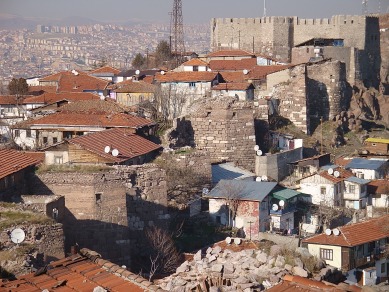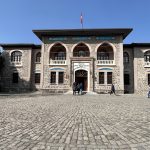“The Castle”
The best place to start exploring Ankara is the Hisar (AKA Ankara Kalesi or Kale for short), the castle which gazes down on Ulus from on high. Like İstanbul, Ankara was built on a collection of hills, and the Hisar bestrides the summit of one of them, with two sets of defensive ramparts ringing it like hoops in the frame of a crinoline skirt; the inner walls in particular are interesting for the sheer density with which towers were built into them. Above them, the walls of the actual castle date back mainly to Selçuk times, although the gate lintels created using old columns, and the ancient altars and inscriptions set into them make it evident that much of the building material came from abandoned Roman and Byzantine properties in the vicinity.
Inside the Hisar
The area enclosed by the Hisar used to be the oldest continually occupied part of town, its narrow streets lined with old Ottoman houses, their upper storeys supported on “saw-teeth” beams. A few of Ankara’s poorer residents continue to maintain a traditional lifestyle here but most will probably be moved out in the foreseeable future. The houses have mainly been demolished and rebuilt to create a cleaner, tidier “Ottoman” look. The result has been to extinguish authentic street-life and replace it with endless shops selling tourist tat.
That said, it’s still worth looking out for the early 13th-century Alaadin Çami whose portico and walls were built by the Selçuks using ancient columns and plinths in such quantities that you have to suspect that there was an old temple either on the site or nearby. The same is equally true of the Şark Kulesi, up steep steps nearby, which offers magnificent views out over Ulus.
Around the Hisar
Immediately opposite the Parmak Kapısı (Finger Gate) is the restored Çukurhan (Han in a Dip), home to the swish and comfortable Divan Hotel, set around a courtyard where traders once jostled for position. A classy restaurant offers a fine view over the Atpazarı (Horse Market), an atmospheric bazaar area where fruit and nuts are sold in vast quantities.
Right next door to the left is the Rahmi M Koç Industrial Museum, a shrine to industrial archaeology housed in the old Çengelhan (Hook Han) which was built by the grand vizier, Rüstem Paşa, in 1522-23 during the reign of his father-in-law, Sultan Süleyman the Magnificent. At the time it was said to be one of the four finest hans in existence with a vast stable to accommodate the camels of passing traders, many of whom came here to snap up the wool for which Angora was famous.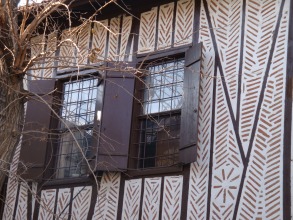
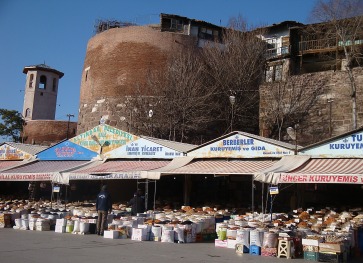 If you turn left from the Parmak Kapısi and walk downhill you will pass through the old Samanpazarı (Hay Market), now home to most of the town’s antique and carpet dealers. The Çengel and Cukur hans were just two of a series of hans and two more lurk here: the ramshackle Pilavoğlu Han contains a series of art and craft workshops with a small courtyard cafe, while the Pırınç Hanı offers more shops and another cafe in rather better conditions.
If you turn left from the Parmak Kapısi and walk downhill you will pass through the old Samanpazarı (Hay Market), now home to most of the town’s antique and carpet dealers. The Çengel and Cukur hans were just two of a series of hans and two more lurk here: the ramshackle Pilavoğlu Han contains a series of art and craft workshops with a small courtyard cafe, while the Pırınç Hanı offers more shops and another cafe in rather better conditions.
Further downhill the 13th-century Ahi Elvan Cami is a slightly less grand “forest mosque” also full of wooden columns topped off with reused masonry.
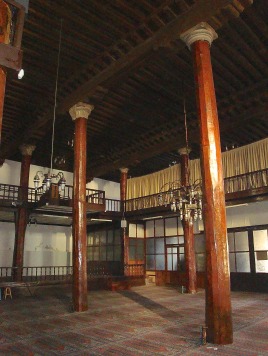 Ahi Elvan Cami
Ahi Elvan Cami
Eating
The best restaurant is the one in the Divan Hotel although the Çukurhan also has a patisserie for quick coffees with cake. The cafe in the Erimtan Museum next door has a large outdoor terrace away from the traffic and so perfect for high summer. Inside the Hisar the And Cafe occupies the top floor of an old house with fine views although the menu offers only standard international fare.
The Hisar Kasrı built onto the outer walls of the Hisar does at least offer fine views out to make up for the visual damage it does to them.
Sleeping
For visitors this is the most atmospheric part of town in which to stay although a bed won’t come cheap.
And Hotel, Kale. Tel: 0312-310 2304
Transport info
No buses serve the Hisar. If you can’t face the steep climb up from Ulus to the castle you could take a taxi up and then walk back down again through Hisar Park.
